A resistance band is a length of latex or rubber that produces resistance when stretched.
That resistance is equivalent to various amounts of weight, making resistance bands an affordable, low-impact method of strength training.
Resistance bands are widely prescribed for those looking to rebuild strength in the aftermath of an accident or injury.
They also enable those with arthritis to maintain joint strength and flexibility while their compact size and light weight means they travel well.
The following is our list of the best resistance bands, updated for 2023.
Rankings
1. Gymbandit Premium-Quality Resistance Bands
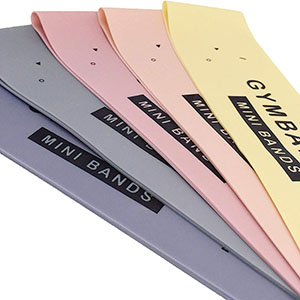
Click here for the lowest price on Amazon
These are ‘mini’ bands. Meaning they’re intended for self-contained resistance training where (for example) you might loop one end around each arm and then pull your arms away from each other. They’re made from real latex, not cheap synthetic fillers. And the company offers a full money-back satisfaction guarantee.
What we like: We like that they’re made from genuine latex. We like that the resistance is not outrageous. And we like that they’re color-coded to indicate various resistance levels. The cinch sack also makes it easy to take these on the road.
Flaws: The bands are pretty wide, so if they’re not used properly, they’ll roll up, especially during upper leg exercises.
2. Perform Better Light Exercise Bands
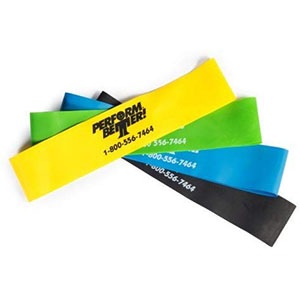
Click here for the lowest price on Amazon
Perform Better Light Exercise Bands are a good choice for older folks looking for a safe and effective entry point into the world of resistance training. The resistance here is pretty modest, yet still enough to get you going and produce positive results. Just keep in mind that these are mini bands.
What we like: They’re inexpensive, well-made and versatile. All things we want to see in resistance bands. They’re also color-coded to indicate various levels of resistance. And they’re comfortable against the skin.
Flaws: The thinnest bands tend to roll up during some exercises. Also, if you push the thinner bands too hard, they’re likely to snap.
3. Black Mountain Products Resistance Band Set
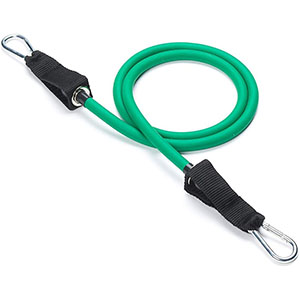
Click here for the lowest price on Amazon
This set is a good choice for beginners or those with a bit more experience with resistance training. The heaviest band has an equivalent ‘weight’ of 25-30 pounds and, because these are tube bands with handles, you have a full range of exercise options.
What we like: Many manufacturers leave you to guess about the equivalent weight of their bands. Black Mountain tells you. We like that. These bands range from lightweight (yellow, 2-4 pounds) to heavyweight (red, 25-30 pounds).
Flaws: The exercise ‘guide’ is nothing to write home about. And the handles need to be inspected before each use in case they’re compromised.
4. TheraBand CLX Resistance Band
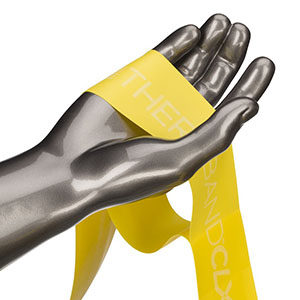
Click here for the lowest price on Amazon
The TheraBand CLX is a single resistance band with multiple loops along its length. These different loops provide a range of exercise options. It’s the kind of versatility we like to see and means you don’t have to carry around multiple bands.
What we like: We like that the resistance here is relatively mild. That makes them a good choice for older folks. And we like that the single band provides myriad exercise options.
Flaws: Not for those seeking a hard-core workout. And there’s only one band. So if it breaks, you’re back to square one.
5. Canway Pull Up Bands

Click here for the lowest price on Amazon
Canway makes high-quality resistance bands that will satisfy users of different experience levels. These loop bands provide a full range of exercise options and make ideal additions to your home gym. Use them as mini bands or to provide a bit of a boost during pullups.
What we like: We appreciate that the bands are not just color-coded they’re different widths. The bands are also very durable, and you should not have a problem with them rolling up during leg exercises.
Flaws: Some of the marketing suggests they’re rubber. They’re actually latex rubber, which is slightly different. So, if you have a latex allergy, take note.
6. Dynapro Exercise Resistance Bands
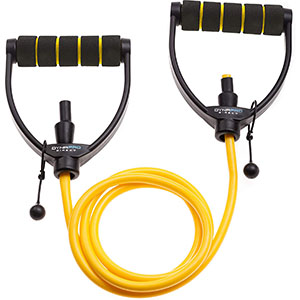
Click here for the lowest price on Amazon
Tube bands like this allow you to obtain a full-body workout with little muss or fuss. With a range of weights available, you can start out easy and gradually increase the intensity of your workout.
What we like: We like the comfort afforded by the grips. We like that the different weights allow you to get the workout that’s right for you. And we really appreciate that 1-year manufacturer’s warranty.
Flaws: The ‘adjustment’ ball (more of a strap really) isn’t all that effective. And if your form isn’t perfect, the handles can be a bit punishing when you do curls.
7. Fit Simplify Resistance Loop Exercise Bands
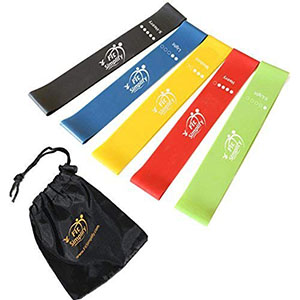
Click here for the lowest price on Amazon
Fit Simplify Resistance Loop Exercise Bands make a good choice for the beginner. The resistance levels are relatively modest. The bands are generally well-made and tend to retain their integrity through repeated use. And the illustrated guidebook answers any questions you have about how to use mini bands.
What we like: We like it when companies keep products like this simple. You get five wide flat bands of varying resistance levels, a carry bag, and access to some instructional videos. There’s also a good-sized eBook that illustrates various exercises.
Flaws: Not the most durable resistance bands on our list. Plus, the instructional video is something less than inspiring.
8. Serious Steel 41″ Assisted Pull-up Band

Click here for the lowest price on Amazon
Serious Steel offers seven different resistance band packages. The bands range in weight from 5 – 120 pounds, so there’s something for every strength and experience level. They’re made from premium latex and are unlikely to snap.
What we like: There’s no doubt these are tough, effective resistance bands. We like that the upper end is 120 pounds. That makes this set a good choice for those looking for an intense, but low-impact workout.
Flaws: They tend to start fraying after a month or so of regular use. Nothing serious but not what we expected for the price.
9. OlarHike 13pcs Resistance Bands Set
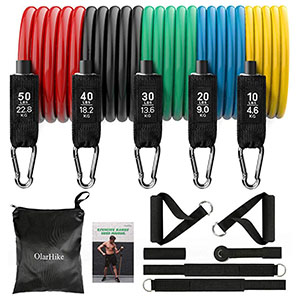
Click here for the lowest price on Amazon
This comprehensive set of tube-style resistance bands should appeal to anyone from the total novice to the workout veteran. You get a complete range of exercise options and all the peripherals needed to get you going. The bands are well-made, and the included workout guide should answer most of your questions.
What we like: Those looking for a complete resistance training experience are going to appreciate this set of bands from OlarHike. We like that they provide a full range of ‘weights’ from 10 pounds (yellow) up to 50 pounds (red).
Flaws: If you ‘stack’ too many bands, the handles may not be able to withstand the load.
10. Bodylastics Resistance Bands Set

Click here for the lowest price on Amazon
The last of our resistance band sets is this one from Bodylastics. This is a comprehensive set of tube-style exercise bands that allow you to select a wide range of resistance settings. They also have some of the most comfortable handles you’ll find anywhere.
What we like: We appreciate they’ve taken some extra steps to ensure user safety in the event of a snap. And we like that they provide the chance for a comprehensive full-body workout.
Flaws: If you’re buying them for the free lessons etc. you may wind up disappointed. The free stuff ends pretty quickly, and then they spam you to upgrade.
Who Should Use Resistance Bands?
Anyone interested in achieving a higher level of overall health should consider incorporating resistance bands into their workout. Even if you don’t have an established workout routine, you should consider using resistance bands to increase strength and fend off the possibility of injuries due to a weakened body.
Resistance bands are also commonly prescribed for people recovering from accidents or injury. Particularly injuries to the hips, knees, and ankles. And a growing amount of evidence supports the notion that those with arthritis would benefit from resistance band exercises. That said, older folks – whether they have arthritis or not – will benefit significantly from the increases in overall strength they can obtain through resistance training (1).
How We Ranked
When ranking resistance bands for our list we looked at a number of factors starting with the type of bands. There are two basic types on the market. They are ‘flat’ and ‘tubed’. Flat bands are generally made of latex and are available as linear bands with open ends that you grab with your hands. You can also get them with the ends joined together to form a loop.
When it comes to the open, linear type of bands, we want them to be easy to grab hold of and to be extremely durable. You can apply a surprising amount of force to this type of band if you put it under your feet and push off with your legs. The band has to be able to withstand that. Looped bands, especially the wider variety, should stay where you put them on your legs and not roll up when you raise one leg or the other.
Tube bands are typically made of either natural or synthetic rubber. They are harder to the touch than flat bands. Because of this, you won’t be wrapping this type of band around the thighs to do upper leg exercises. This type of band usually comes with handles or clips attached to each end. You either attach the clip to some fixed object, or you hold the handles in your hands. Because of this, we looked for handles and clips that are firmly affixed to the band.
There were other things we looked for as well. Were the bands offered as a set with various resistance levels? Could you purchase the different strength levels separately? Do the bands indicate different ‘weights’ by way of different colors? (Very convenient, that.) And finally, were/are they durable and affordable?
FAQs
Q: What are resistance bands?
A: Resistance bands (sometimes called ‘exercise bands’) are strips of latex or rubber that are used to perform resistance training. The force required to stretch them out mimics the force needed to lift various amounts of weight and produces the same effect on the body. Those effects include increased strength, greater stamina, reduced body fat, enhanced cardiovascular health, and much more. Resistance bands can be used alone or in concert with other equipment. Different bands are typically used for different exercises. So-called ‘mini bands’ (2) are used for things like face pulls, legs splits and overhead presses. Larger bands are used for things like deadlifts, squats, and pull-ups.
Q: What are resistance bands good for?
A: Above, we outlined just some of the numerous benefits that can be enjoyed by working out with resistance bands. Those benefits include increased strength (essential for older folks), enhanced mobility (just as important as strength for the not so young), and reduced likelihood of injury (crucial to a happy, healthy old age). Those, and all the secondary benefits they spawn, should be more than enough to justify buying some resistance bands. They’re also inexpensive for those on a budget.
Q: Can seniors gain muscle using resistance bands?
A: Yes, seniors can gain muscle using resistance bands. Sometimes quite a bit. As we have seen, the belief that physically wasting away is the fate of all those in their 60, 70s, and 80s is a myth. Older individuals benefit just as much from resistance training as people in their 20s. Perhaps more when you consider the impact it can make on an older person’s quality of life. Lots of senior weight lifting classes are being run by health clubs these days. There are also numerous websites that provide instruction on how to work out with resistance bands (3). In addition, there are a ton of online videos that will introduce you to effective techniques for working out with resistance bands.
Q: Is training with resistance bands a good idea for those over 50?
A: Extensive research supports the idea that older people who are able should engage in resistance training (4). Some people think that resistance training only means free weights. But while free weights are the most widely practiced type of resistance training resistance bands are not far behind in popularity. So, when you combine the research that indicates resistance training is a good idea for seniors, with the low-impact effectiveness of resistance bands, you get a prescription for robust long term health. And that is equally true for both men and women (5).
Q: Can resistance bands help prevent injuries?
A: As we mentioned, there is copious evidence that resistance training (whether it takes the form of free weights or exercise bands) is beneficial to older individuals (6). Weak muscles increase the odds that a fall will result in a broken bone or bones. Why is that? Because muscles and tendons ensure the physical integrity of the body, including the skeleton. As such, older folks (men certainly, but also women who have osteoporosis) should engage in resistance training to strengthen the muscles and the bones they’re connected to (7). Doing so will not only reduce the chances of breaking a bone but also reduce the likelihood of joint injuries.
Q: Can I use resistance bands if I have arthritis?
A: The benefits of training with resistance bands are many. But one of the least discussed is how they can help folks suffering from arthritis (8). Resistance bands have shown great promise in helping those who suffer osteoarthritis in the knees (9). Training with resistance bands strengthens the knee joint and helps offset the damage caused by arthritis. That helps ensure the stability of the joint, which in turn can help prevent falls and broken bones. Maintaining strong knee joints is also important if older folks are to stay mobile. Loss of mobility is a major cause of declining health in the elderly (10). Conversely, maintaining mobility can go a long way toward maintaining good overall health well into old age.
Q: Can I use resistance bands if I had a hip injury?
A: Yes, you can use resistance bands if you’ve suffered a hip injury. In fact, it’s likely that your doctor will recommend some type of resistance band therapy as part of the recovery process (11). But resistance bands shouldn’t only be used in response to a hip injury. They can also help alleviate the pain and stiffness of hip bursitis (12). Hip bursitis may be the result of injury, or it may simply be the result of years of wear and tear on the hip joint. Resistance bands can help strengthen the joint and restore normal function. The bottom line is that resistance bands are a useful tool for those suffering from various maladies of the hip. And this is true regardless of the person’s age.
Q: Are resistance bands good for rheumatoid arthritis?
A: Many people think that arthritis is arthritis. But there are actually two major and distinct forms of arthritis. Osteoarthritis, which we mentioned above, and rheumatoid arthritis. While osteoarthritis is commonly the result of poor diet, lack of exercise and age, rheumatoid arthritis is a devastating autoimmune disease (13). With rheumatoid arthritis, the immune system mistakenly attacks the joints devouring tissue and often causing painful deformations. Resistance bands can be an important component of a comprehensive exercise program aimed at strengthening the joints and maintaining mobility (14).
Q: Is there some way to prevent resistance bands from rolling?
A: If there is a common complaint people have about wide resistance bands, it’s that they tend to curl or roll up. Most of the time, this happens when the band is wrapped around the thighs during leg strengthening exercises. If the band isn’t ideally placed or the person’s form is a bit off, the band can wind up rolling up the thigh and cause problems. As you may have guessed from that description of the problem, the best way to prevent this happening is to place the bands correctly and practice good form. Also, make sure the band you’re using isn’t any wider than it needs to be.
Q: Will resistance bands help me lose weight?
A: Any type of vigorous exercise can help you lose weight and keep it off. But there are certainly some types of exercise that are better for losing weight than others. Running and walking are two of the best when it comes to burning calories. But resistance training isn’t that far behind. Research indicates that 30 minutes of vigorous resistance training can burn as much as 250 calories (15). That compares favorably to low-impact aerobics or a stairmaster machine. Although it is less than you will burn running. Less vigorous resistance training will burn about 120 or so calories every 30 minutes.
Q: Is there a right and wrong way to clean resistance bands?
A: Cleaning resistance bands is typically easy to do. You simply wipe them down with a clean damp cloth when you’re done and let them dry before putting them away. Don’t store them in direct sunlight as this could weaken them. And don’t use any harsh chemicals to clean them with either. That may undermine the integrity of the material.
Q: Are resistance bands dangerous?
A: Like virtually any type of exercise equipment resistance bands are typically very safe, if you use them properly. Not using them in the manner in which they are intended could, however, lead to injury. A few common-sense rules to follow include not stretching the band further than they’re designed to be stretched. As a general rule of thumb, that’s 2 1/2 times their relaxed length. Also, make sure you inspect the bands carefully before each use. This typically only takes a minute and can help prevent an accident before it happens.
Q: What are some signs my resistance bands are wearing out?
A: If you have colored bands, you’ll want to look for white areas where there is no color. That indicates that the area is losing structural integrity and is likely to snap. There may also be actual cracks in the material. If there are, you shouldn’t use the band. In addition, if the bands have handles attached, inspect the integrity of the band/handle connection before each use. You don’t want the handle snapping off when you’re fully extended.
Related Articles
Recap
Resistance bands are a simple, effective, and affordable way for anyone to improve their overall health. They’re easy to get, easy to use, and don’t chew up real estate in the house like exercise equipment can.
With more and more seniors expressing an interest in staying physically fit for as long as possible, resistance bands are more popular than ever these days. They allow older individuals to stay strong and flexible, enhance their endurance, and build muscle. They also improve heart function and fend off the kind of injuries that are often the undoing of the elderly.
The resistance bands on our list represent the cream of the crop. No matter which physical benefit you’d like to enjoy from exercising, there is a band or bands on our list that can allow you to achieve your goals. And don’t forget you can also use them alongside other exercise equipment to ramp up the health benefits.
For cpoe.org’s #1 recommended resistance bands, click here.

